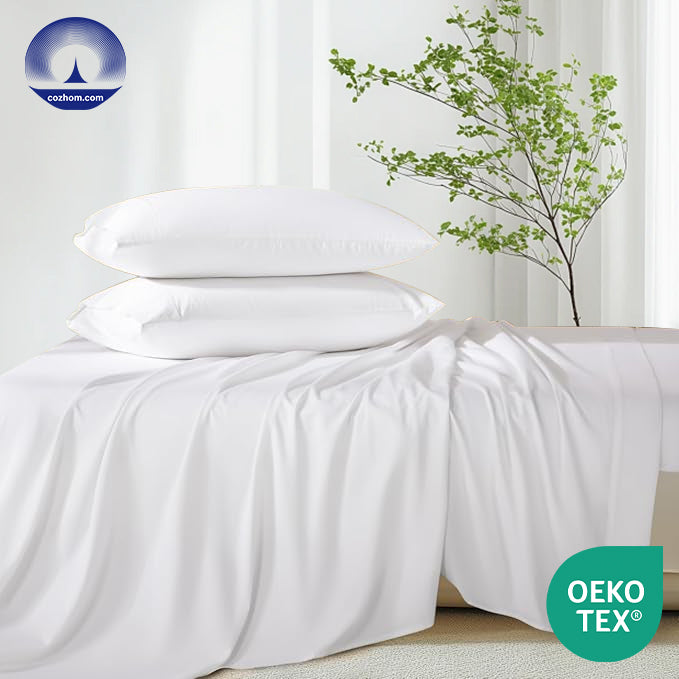
Why Menopausal Women With Insomnia Should Choose COZHOM Bedding
Chia sẻ
Menopause is a life stage that commonly disrupts sleep: studies show that between 40% and 60% of women report sleep disturbances during the menopausal transition, and pooled analyses place sleep disorder prevalence around ~50% among postmenopausal women. These problems are often driven by hot flashes, night sweats, hormonal changes and associated mood or anxiety shifts. For women experiencing these symptoms, standard bedding rarely addresses the physiological drivers of sleep disruption—this is why COZHOM develops bedding specifically for menopausal insomnia.
Menopause, hormones and sleep: the core problems
During perimenopause and menopause estrogen and progesterone levels fluctuate and decline. These hormonal shifts contribute to vasomotor symptoms (VMS)—hot flashes and night sweats—which are a major cause of sleep fragmentation. Research consistently links VMS frequency and severity with increased nighttime awakenings and shorter total sleep time. In short: if you are waking because you get too hot or soaked with sweat, the bedding’s thermal and moisture management matters a lot. :contentReference[oaicite:6]{index=6}
What the evidence says about cooling interventions
Clinical and pilot studies show that bed cooling systems, cooling mattress pads, or temperature-regulating bedding can meaningfully reduce VMS severity and night-time sleep disruption. For example, in controlled pilot work menopausal women using a cooling mattress pad experienced significant reductions in hot flash frequency and improved sleep measures; other interventions reported increases in nightly sleep duration (e.g., average gains around ~20–30 minutes in some pilots). Cooling the sleep surface reduces awakenings caused by overheating and supports longer, more restorative sleep. :contentReference[oaicite:7]{index=7}
Why COZHOM is designed specifically for menopausal insomnia
- Advanced cooling fabrics — engineered to wick moisture and dissipate heat quickly, lowering skin-surface temperature during night sweats.
- Deep-pressure layers — integrated options (weighted/pressure layers) that reduce sympathetic arousal and help fall asleep faster.
- Hypoallergenic & antibacterial textiles — reduce allergen-related awakenings and maintain a clean sleep microclimate.
- Ergonomic fits — tailored sizes and secure fittings to avoid bunching or movement that can wake sensitive sleepers.
Numbers matter: what women actually report
In consumer trials and pilot studies of cooling bedding, participants frequently report marked reductions in night sweats and improved sleep lengths. One recent pilot reported sleep duration increases of about 26 minutes on average and reductions in “sleeping too hot” interruptions by over 40 percentage points for some participants. Those improvements translate to better daytime mood, energy and cognitive performance—core concerns for menopausal women. :contentReference[oaicite:8]{index=8}
COZHOM vs common alternatives: why bedding is part of the solution
Many treatments for menopausal sleep issues focus on hormones, medications, or behavioral therapy (CBT-I). While those are important—CBT-I is highly effective for chronic insomnia—bedding plays a complementary and immediate role. Nonpharmacological approaches that modify the sleep microclimate (temperature, moisture, tactile comfort) have been shown to reduce symptomatic sleep disruption. COZHOM’s approach is to combine evidence-based textile solutions with user-centered design so bedding becomes an active, therapeutic part of sleep care. :contentReference[oaicite:9]{index=9}
Practical guidance: how menopausal women should choose bedding
- Prioritize fabrics with clear cooling/evaporative properties and moisture-wicking claims supported by test data.
- Consider a layered approach: cooling sheet + lightweight duvet + optional deep-pressure layer for nights of anxiety.
- Look for hypoallergenic, antimicrobial finishes if you are allergy-prone.
- Test with a sample—COZHOM offers sample options so you can confirm effects on your own night sweats before buying full sets.
Conclusion — COZHOM: targeted bedding for menopausal insomnia
Menopausal sleep disruption is common and multifactorial, but the sleep microclimate is a tractable target. By combining cooling textiles, deep-pressure comfort, and hypoallergenic treatments, COZHOM delivers bedding engineered to reduce VMS-related awakenings and improve sleep duration and quality for menopausal women. For women seeking nonpharmacological, immediate relief that complements medical care (or provides practical night-to-night help), COZHOM is purpose-built for this life stage. :contentReference[oaicite:10]{index=10}
Ready to test COZHOM? Order a sample set or contact our sleep specialists to find the right combination for your needs.